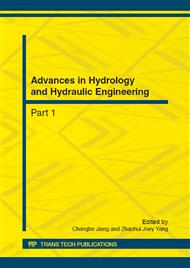p.951
p.957
p.963
p.970
p.974
p.981
p.985
p.989
p.998
Analysis on the Dynamical Law of the Dam's Displacement by the Concept of Time-Displacement
Abstract:
In the analysis of dam displacement data, mostly, a single point is used for calculation. Based on the concept named Time-displacement, this paper proposes a new calculation method with multi-point, which can make up the scarcity of analysis on the data of the dam deformation for a long time. Based on the concept of Time-displacement, the method of building the multi-point model is as follows: firstly, according to the deformation monitoring period, displacement data of all monitoring points on the deformation body, can be converted into the displacement rate. And based on displacement rate value, an appropriate rate threshold can be chosen; the rate threshold based on the experience can be used many also. Then the number of every monitoring point exceeding the rate threshold throughout the monitoring period can be recorded, and according to the number, the monitoring points’ Time-displacement could be divided into different levels. If the number of monitoring points on the deformation body is less, the interpolation points would be laid along the direction of the original monitoring sites. By the method of decision tree classification, the interpolation points’ Time-displacement could be figured out. Finally, with the original monitoring points and the interpolation points, the figure about deformation body’s Time-displacement could be drawn, which can reflect the displacement situation about the deformation body more dynamically.
Info:
Periodical:
Pages:
974-978
Citation:
Online since:
October 2012
Authors:
Price:
Сopyright:
© 2012 Trans Tech Publications Ltd. All Rights Reserved
Share:
Citation:


